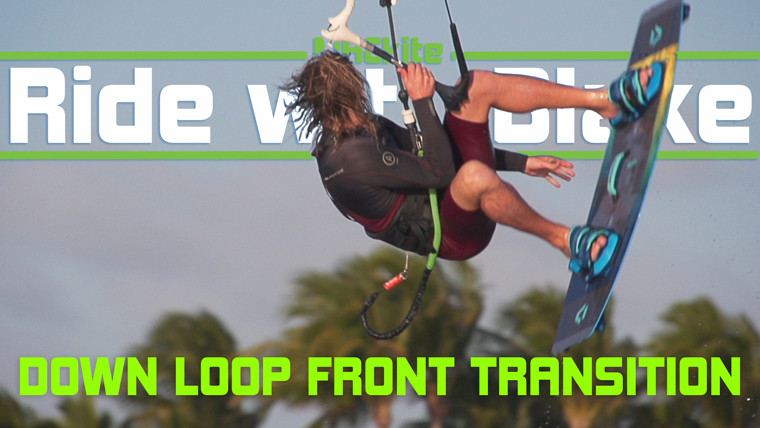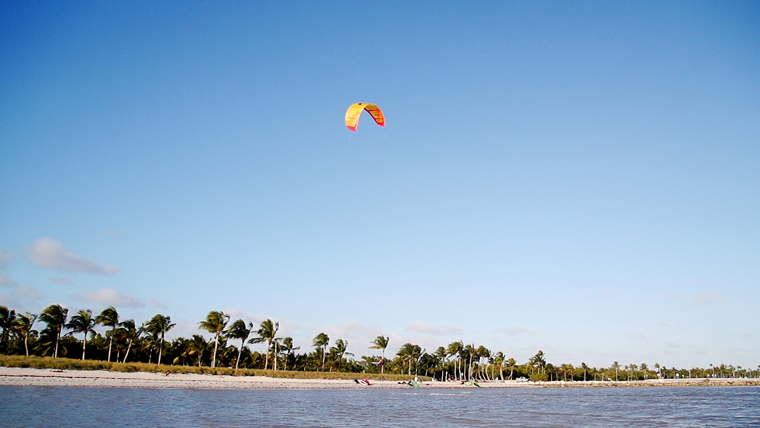Down Loop Front Roll Transition - Ride with Blake
Today Rygo and I are going to be covering a very important topic, one that will change the way you transition forever. The reason downloops are so cool is because they're basically a shortcut to more powered transitions, used for riding waves, carving turns and riding in light winds. Make sure to do this while slightly under-powered to minimize risk of injury.
This is one of our more advanced videos. The good news is that we have three tutorials you should master before attempting this trick.
Check out our toeside tutorial! We also have a basic downloop to toeside video as well. Lastly, watch our frontroll stalefish video. If you can do all three of these, you are good to go on this incredible intermediate trick.
We recommend you download the attached PDF on your phone. Check it before your next session!
Give the kite room to loop at the edge of the wind window
Step One- Kite High
Put your kite high at 45 degrees or higher in the wind window. This will give you room to loop the kite without it hitting the water. Your kite is going to be looping down towards the water and into the other direction. The lower the kite is in the wind window, the harder it will be to pull in on the bar to get the loop around. A quick tip for this is to send the kite up higher right before you initiate the loop, giving you room for the loop.
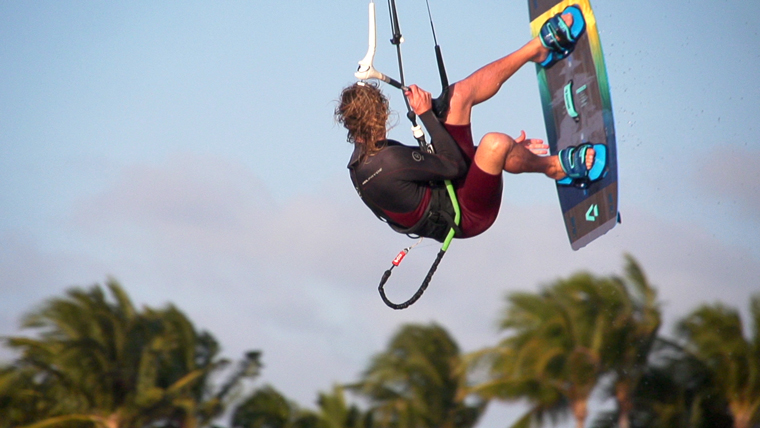
You don't have to do a complete roll
Step Two- Throw a Half Front Roll
This is going to be a little different than a normal frontroll. In our last playlist, we talked a lot about off-axis rolls. Meaning you will not be inverting or flipping, you’ll be spinning or rolling around your center lines. After you pop and send the kite, look over your front shoulder.
Unlike a regular frontroll where you look into your armpit, you want to throw your head and back shoulder back, opening up your chest. Bring your back knee into your chest and poke out your front leg. It helps to take your back hand off on this step. Give our frontroll stalefish video a watch if you need more help on frontrolls.
That grab will go great with this trick. The biggest difference here is that you are incorporating a downloop and landing toeside. That means you won’t have to spin as much and the loop is going to help pull you out of the roll. For that reason, you don’t need to rotate a complete roll on this step.
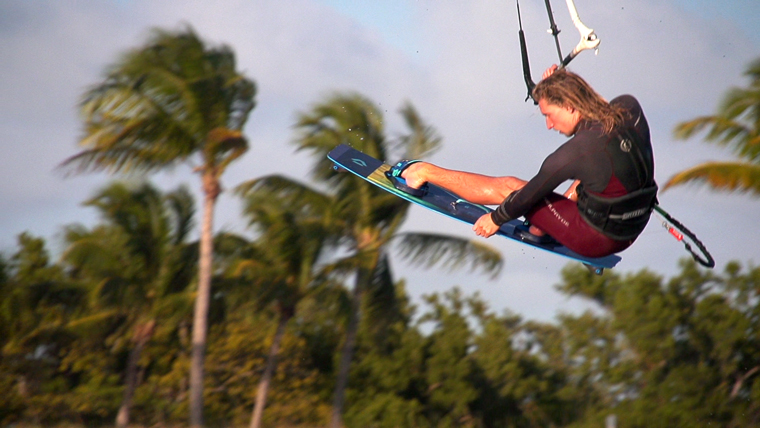
Use the loop to pull you into your landing
Step Three- Use the Downloop
This is the most important part of the trick. Your kite is going to be looping through the power zone so it will generate a lot of downwind pull; it’s also going to pull you through the second half of the rotation. You’ll want to pull the trigger right before you land on your toeside. If you’re feeling hardcore, you can pull the trigger at the apex of your jump but you’ll need to catch yourself by sending the kite back to noon before you land. That can be complicated and intense if you mess up. When learning we recommend keeping it simple and using this as an impressive transition.
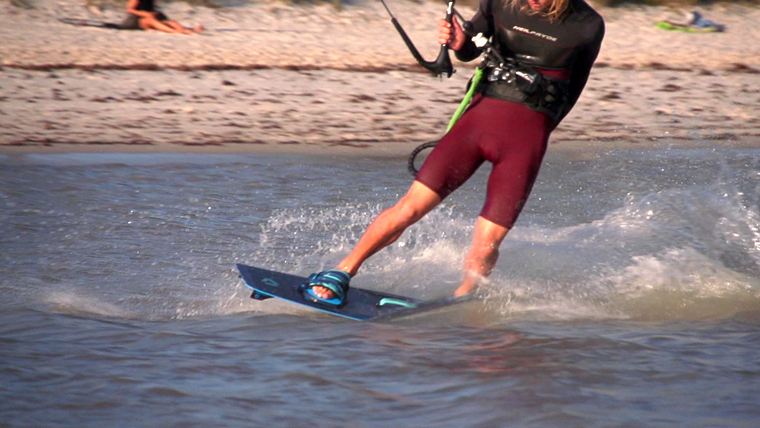
Land flat with your toeside hip forward the kite will pull you onto edge
Step Four- Landing toeside
This is the fun part. Because you’re landing on your toeside, you won’t have to do a complete front roll. It’s more like a 270 than a 360. You're also going to be landing downwind, not on your edge. The fun in this trick is that you’ll actually be landing almost in the heelside position for the opposite tack. In fact, as soon as you land downwind and ride out some of the power, you’ll lean back and edge into the heelside position in the other direction. This is possibly the coolest feeling transition that I know.
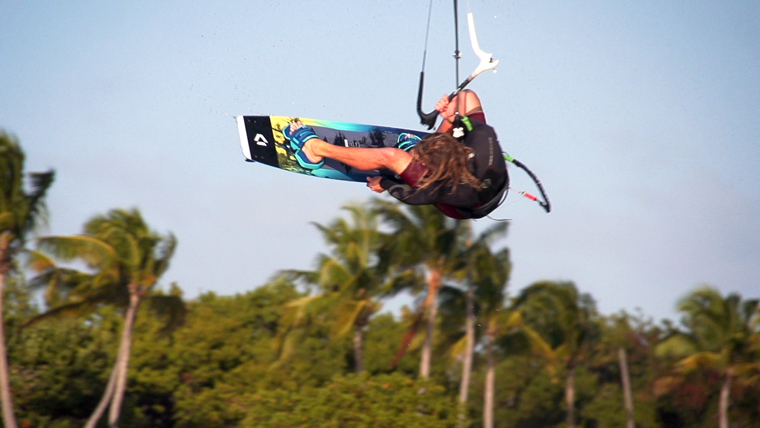
Step Five: Work your way into it
Don’t feel like you have to loop while you are in the air. You can also start the loop after you touch down. This will be easier on the body, and it will be a safer way to get comfortable learning this trick. You don’t have to take it any further than this, but it’s going to feel amazing if you do.
Recommended gear
When it comes to kiteloops, most kites will get the job done, especially for beginners. That said, some gear does work much better than others. A great rule of thumb is to learn on something no bigger than an 11 or even 10 meter. Larger kites will still loop, but they are much slower, more difficult, and not very effective. There are several categories of kites that cater to different styles of riding. We much prefer the freestyle kites in most brands' lineups. That said, many of the freeride kites do work. To demonstrate this, we used the Cabrinha Switchblade 11 to film the majority of this list.
For intermediate to advanced kiteboarders
The fastest, most powerful kites for loops fall in the crossover category. These are three-strut C Hybrid kites designed specifically with kitelooping in mind.
Duotone Dice - Cabrinha FX - Liquid Force NV - Naish Dash - Cabrinha Switchblade 11m
The Switchblade is an outlier on this list. It's technically a freeride kite. The FX is superior in speed and arc, yet the Switchblade packs some power. We chose to film with this kite due to its powerful low end. As we were filming in the Keys, the wind could be quite light. We don't recommend going larger than the 11 for kiteloops unless you are an advanced kiteboarder.
For newer to intermediate kiteboarders
These are faster freeride kites. They're not designed specifically for kiteloops, but as they are all faster they work quite well. They also tend not to be as powerful when looping. The RPM might be the most powerful on this list.
Duotone Evo - Cabrinha Moto - Slingshot RPM - Naish Pivot
These are just a few kites that we prefer. There are plenty of good options beyond these. If you already have a freeride kite and are new to loops, switching to a crossover kite will not make or break your progress. It will, however, help. If you are a more advanced rider, chances are you've already made the switch to something designed with loops in mind. Either way you go, we encourage you to simply have fun with it. Kiteloops can be scary and like any kiteboarding trick, they can be frustrating. Take your time and learn to enjoy the process.
-Rygo
-Written and produced by Blake Olsen & Ryan (Rygo) Goloversic.
 Blake Olsen
Blake Olsen
A Michigan boy through and through (even though he was born in Saudi Arabia), Blake is a youth with a lifetime of experiences and adventures. Not only that, he's passionate about sharing his zest for life with others. He is proficient at many fields, including kiteboarding and acting as concierge to any who simply ask. Looking for an adventure? Well, Blake is your guy. From sailing the Gulf and the Caribbean to backpacking Hawaii and Southeast Asia, he knows his stuff and can make your vacation into an adventure.
Webpage: BlakeTheOlsen.com
Instagram: @BlakeTheOlsen
 Ryan (Rygo) Goloversic
Ryan (Rygo) Goloversic
Just a dude from a kite shop testing all the gear one session at a time.
Many people dream of quitting their job, traveling the world and pursuing their passions. Rygo is one of those people who pulled the trigger. A few years into a postal career, he decided to change everything and travel as a kiteboarder, freelance videographer & writer. His mission is to help people and share the stoke. Get out there and kite!
Producer of: Ride with Blake I Sessions I Versus I Destinations I Foil Fridays
Recent Posts
-
North Navigator Pro Quick Release | How to Swap Yours Out With Ease
What You Need Before starting the replacement process, ensure you have all the necessary t …18th Apr 2024 -
Foil Drive | Essential Tips to Supercharge Your First Session
The Foil Drive makes your foiling life easier. You'll get up easier and catch more waves, …17th Apr 2024 -
2024 Duotone Slick Wing Review | What's New in This Year's Model?
The Duotone Slick has been a favorite of many for several years. Pros love it for its speed, …15th Apr 2024

